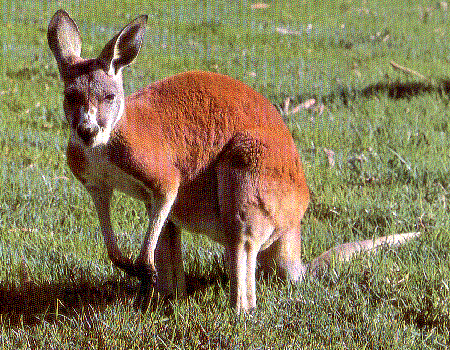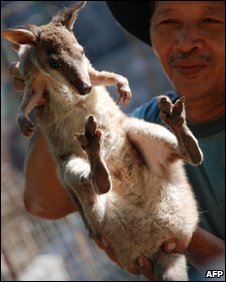Hey Joe, What Kind Of ‘Roos Were They?
Posted by: Loren Coleman on December 7th, 2009
The early history of animal collecting tended to be the source of new species. What would happen is that local people gathered animals to sell to mostly European animal collectors for zoos, and during that process new creatures were “discovered” by Western science. After all, the locals and indigenous peoples (the “natives” of Victorian Times) are the individuals who find these animals. Take, for example, the first recovery of living giant pandas, brought out by Ruth Harkness but actually pulled from that tree trunk from a local animal man.
Nowadays, of course, zoos are mostly trading with each other, to keep a full zoo via internal breeding programs. Nevertheless, a vast underground pet trade is being supplied by local folks and animal collectors, as in the past. Most of it is illegal, and due to that reality, new species gathered may be slipping through the cracks, going un- or underreported to zoology.
When I read the following breaking news coming out of New Guinea this weekend, I naturally wondered, “What species were recovered in this dragnet?”
Could some of these so-called “rare” animals be new species?
Here’s what the BBC News shared on the story:
An Indonesian man has been arrested on suspicion of smuggling 10 rare kangaroos from their native habitat of New Guinea island.
Five were dead when the man was caught off-loading the marsupials in the East Java provincial capital of Surabaya, police there said.
It was not clear which species of kangaroo were found. They are also native to Australia.
The five surviving animals were given to an animal sanctuary.The suspect faces up to five years in jail and 100 million rupiah ($11,000) fine if found guilty of breaching Indonesian conservation laws.
Maj Widarmanto of the East Java police said: “The man said that he bought the kangaroos for two million rupiah ($212) each.”
Digging a bit deeper, The Jakarta Post added this, which might answer my question:
During his arrest, 10 red kangaroos from Papua were seized. Red kangaroos are a protected species in Indonesia….
ProFauna Indonesia head Rosek Nursahid said this was not the first case of illegal trade in red kangaroos in the Madura Strait, but that it was the first uncovered by local authorities.
“ProFauna activists in Papua tell us the trade of red kangaroos is widespread, with animals going to Tanjung Perak Port in Surabaya, and Banyuwangi in East Java,” he said. – JP
Does the photo of one of these recovered kangaroos match “red kangaroos”?

Australia’s red kangaroo (Macropus rufus), file photo.
Macropus rufus are not, reportedly, known from Papua, so some common name confusion is involved here too.
What kind of animals are out there in private collections? Are any new species coming into the pet trade straight from indigenous peoples?
This is from the AP Newswire for today, December 7, 2009:
Malaysian kept honey bear, leopard cat in condo
KUALA LUMPUR, Malaysia — Authorities arrested a Malaysian woman after finding a baby honey bear, a leopard cat and a slow loris primate in her condominium, a wildlife official said Monday.
Officials acting on a tip discovered the endangered species at the 25-year-old woman’s apartment in a Kuala Lumpur city high-rise in a raid Friday, said Mohammad Khairi Ahmad, deputy director of the Selangor state Wildlife Department.
The animals, worth hundreds of dollars on the black market, were apparently kept as pets because the cage for the slow loris — a lemur-like animal — was equipped with swings.
Initial investigations showed the animals were bought from indigenous tribes in southern Negeri Sembilan state about three months ago, Khairi told The Associated Press. The department will get a court order to send the animals to a zoo or release them back to the wild, he said.
The woman, who has been released on bail, claimed her male cousin was the owner of the animals and authorities are now searching for him, Khairi said. Both could be charged for keeping endangered wildlife without permit. They could be jailed for up to two years and fined for each animal, he said.
Khairi said the honey baby bear could fetch about 5,000 ringgit ($1,471) on the black market, while the leopard cat and the slow loris were worth about 500 ringgit ($147) each.
About Loren Coleman
Loren Coleman is one of the world’s leading cryptozoologists, some say “the” leading living cryptozoologist. Certainly, he is acknowledged as the current living American researcher and writer who has most popularized cryptozoology in the late 20th and early 21st centuries.
Starting his fieldwork and investigations in 1960, after traveling and trekking extensively in pursuit of cryptozoological mysteries, Coleman began writing to share his experiences in 1969. An honorary member of Ivan T. Sanderson’s Society for the Investigation of the Unexplained in the 1970s, Coleman has been bestowed with similar honorary memberships of the North Idaho College Cryptozoology Club in 1983, and in subsequent years, that of the British Columbia Scientific Cryptozoology Club, CryptoSafari International, and other international organizations. He was also a Life Member and Benefactor of the International Society of Cryptozoology (now-defunct).
Loren Coleman’s daily blog, as a member of the Cryptomundo Team, served as an ongoing avenue of communication for the ever-growing body of cryptozoo news from 2005 through 2013. He returned as an infrequent contributor beginning Halloween week of 2015.
Coleman is the founder in 2003, and current director of the International Cryptozoology Museum in Portland, Maine.











looks to me like a juvenile agile wallaby – macropus agilis, but i am no aussie expert, here in south africa we have real mammals (and rugby teams ;))
‘What kind of animals are out there in private collections? Are any new species coming into the pet trade straight from indigenous peoples?’
For sale one 3 year old Chupacabra. House trained. Doesn’t do well with other pets especially goats. All shots. $750.
Indonesian Kangaroo
You’re correct in stating that it is not the common Australian Red Kangaroo. But then again, slightly off-topic, the more often seen (by myself) the Eastern Grey Kangaroo is rarely really all “grey” as the naming may suggest but a varying mixture of grey / tan / brown / reddish colo(u)ring with a black-tipped tail to boot.
I’ll investigate some more to see if I can track down the species in question.
Geez—I guess the animals were either kept in a “soundproof” room or just naturally did not make much noise, since apparently the neighbors were not aware of this. Hmmmmmmm.
Anyway, I agree it looks like some sort of Indonesian Kangaroo.
Interesting story, for sure.